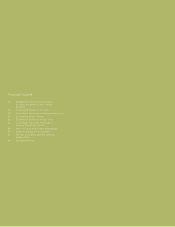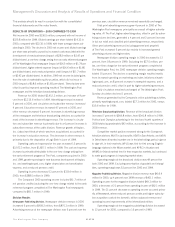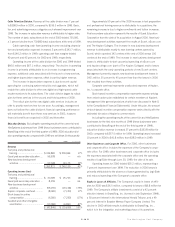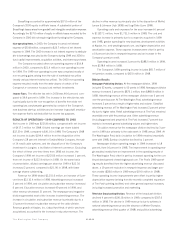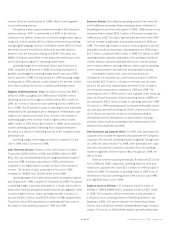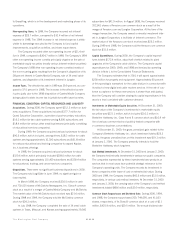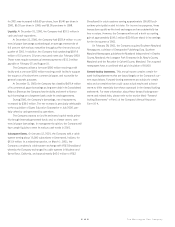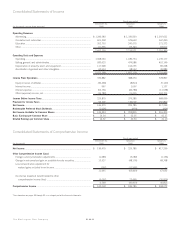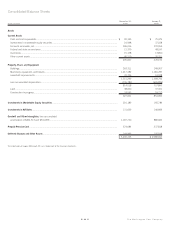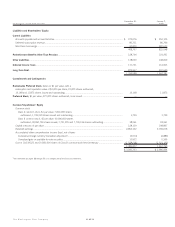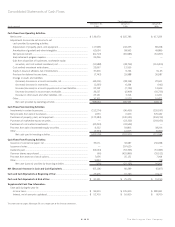Washington Post 2000 Annual Report Download - page 3
Download and view the complete annual report
Please find page 3 of the 2000 Washington Post annual report below. You can navigate through the pages in the report by either clicking on the pages listed below, or by using the keyword search tool below to find specific information within the annual report.
Cable Television Division. Revenue at the cable division rose 7 percent
to $358.9 million in 2000, compared to $336.3 million in 1999. Basic,
tier, and advertising revenue categories each showed improvement over
1999. The increase in subscriber revenue is attributable to higher rates.
The number of basic subscribers at the end of 2000 totaled 735,000,
a 1 percent decline from 739,850 basic subscribers at the end of 1999.
Cable operating cash flow (operating income excluding deprecia-
tion and amortization expense) increased 2 percent to $143.7 million,
from $140.2 million in 1999; operating cash flow margins totaled
40 percent and 42 percent, for 2000 and 1999, respectively.
Operating income at the cable division for 2000 and 1999 totaled
$66.0 million and $67.1 million, respectively. The decline in operating
income is primarily attributable to an increase in programming
expense, additional costs associated with the launch of new services,
and higher depreciation expense, offset in part by higher revenue.
The increase in depreciation expense is due to recent capital
spending for continuing system rebuilds and upgrades, which will
enable the cable division to offer new digital and high-speed cable
modem services to its subscribers. The cable division began its rollout
plan for these services in the second and third quarters of 2000.
The rollout plan for the new digital cable services includes an
offer to provide services free for one year. Accordingly, management
does not believe the cable division’s financial operating performance
will materially benefit from these new services in 2001; however,
financial benefits are expected in 2002 and thereafter.
Education Division. Excluding the operating results of the career fair and
HireSystems businesses from 1999 (these businesses were contributed to
BrassRing at the end of the third quarter of 1999), 2000 education divi-
sion operating results compared with 1999 are as follows (in thousands):
2000 1999 % change
Revenue
Test prep and professional
training....................................... $ 244,865 $ 209,964 17%
Quest post-secondary education .... 56,908 — n/a
New business development
activities..................................... 52,048 30,175 72%
$ 353,821 $ 240,139 47%
Operating income (loss)
Test prep and professional
training....................................... $ 30,399 $ 25,733 18%
Quest post-secondary education ... 8,359 — n/a
New business development
activities..................................... (56,155) (20,128) 179%
Kaplan corporate overhead........... (8,365) (7,153) 17%
Stock-based incentive
compensation ............................ (6,000) (7,250) (17%)
Goodwill and other intangible
amortization ............................... (10,084) (6,861) 47%
$ (41,846) $ (15,659) 167%
Approximately 50 percent of the 2000 increase in test preparation
and professional training revenue is attributable to acquisitions; the
remaining increase is due to higher enrollments and tuition increases.
Post-secondary education represents the results of Quest Education
Corporation from the date of its acquisition in August 2000. New busi-
ness development activities represent the results of Score!, eScore.com
and The Kaplan Colleges. The increase in new business development
revenue is attributable mostly to new learning centers opened by
Score!, which operated 142 centers at the end of 2000 versus 100
centers at the end of 1999. The increase in new business development
losses is attributable to start-up period spending at eScore.com
and kaplancollege.com (part of The Kaplan Colleges) and to losses
associated with the early operating periods of new Score! centers.
Management presently expects new business development losses in
2001 will be 35 percent to 45 percent less than the losses in 2000
that resulted from these activities.
Corporate overhead represents unallocated expenses of Kaplan,
Inc.’s corporate office.
Stock-based incentive compensation represents expense arising
from a stock option plan established for certain members of Kaplan’s
management (the general provisions of which are discussed in Note G
to the Consolidated Financial Statements). Under this plan, the amount
of stock-based incentive compensation expense varies directly with the
estimated fair value of Kaplan’s common stock.
Including the operating results of the career fair and HireSystems
businesses for the first nine months of 1999 (these businesses were
contributed to BrassRing at the end of the third quarter of 1999),
education division revenue increased 37 percent to $353.8 million for
2000, compared to $257.5 million for 1999. Operating losses increased
10 percent in 2000 to $41.8 million, from $38.0 million in 1999.
Other Businesses and Corporate Office. For 2000, other businesses
and corporate office includes the expenses of the Company’s corpo-
rate office. For 1999, other businesses and corporate office includes
the expenses associated with the corporate office and the operating
results of Legi-Slate through June 30, 1999, the date of its sale.
Operating losses for 2000 totaled $25.2 million, representing a
7 percent improvement over 1999. The reduction in 2000 losses is
primarily attributable to the absence of losses generated by Legi-Slate
and reduced spending at the Company’s corporate office.
Equity in Losses of Affiliates. The Company’s equity in losses of affili-
ates for 2000 was $36.5 million, compared to losses of $8.8 million for
1999. The Company’s affiliate investments consist of a 42 percent
effective interest in BrassRing, Inc. (formed in late September 1999),
a 50 percent interest in the International Herald Tribune, and a 49
percent interest in Bowater Mersey Paper Company Limited. The
decline in 2000 affiliate results is attributable to BrassRing, Inc.,
which is in the integration and marketing phase of its operations.
28 The Washington Post Company

